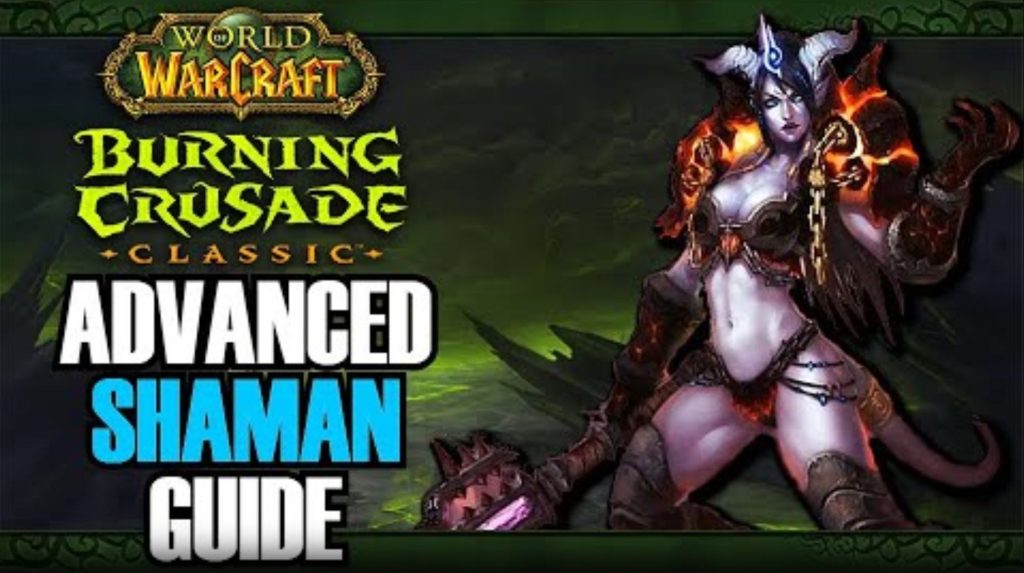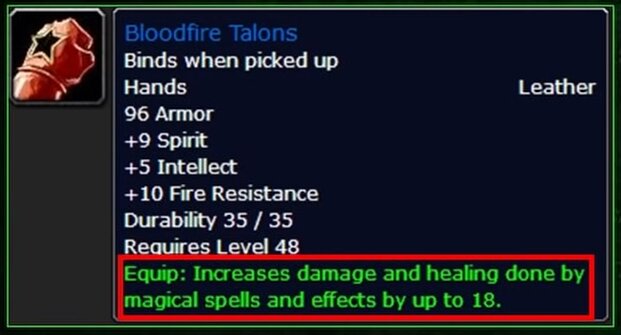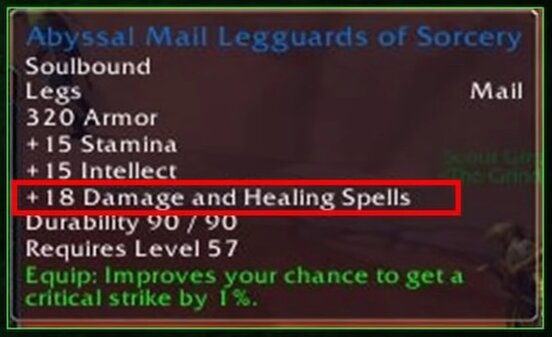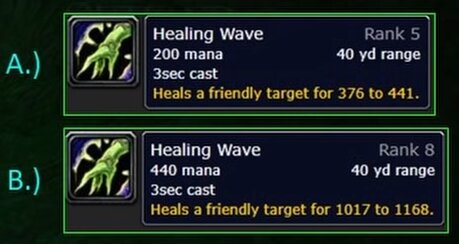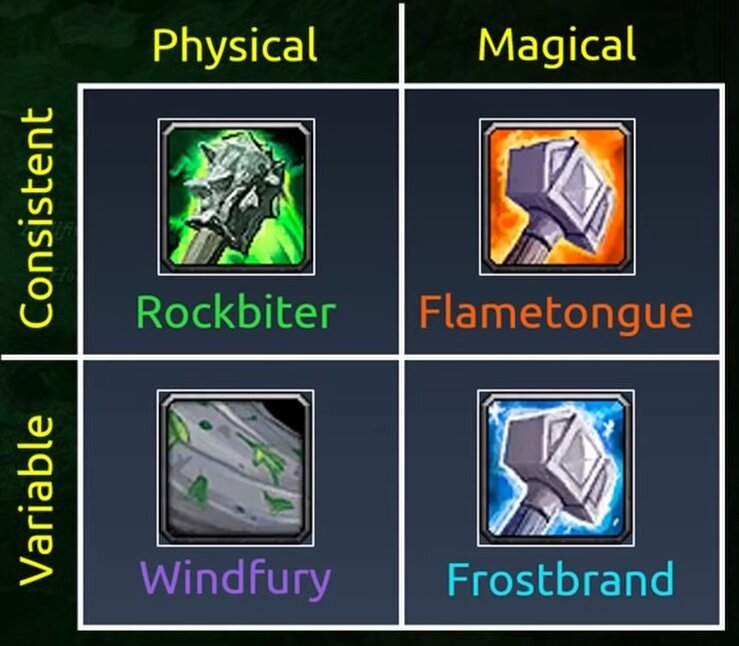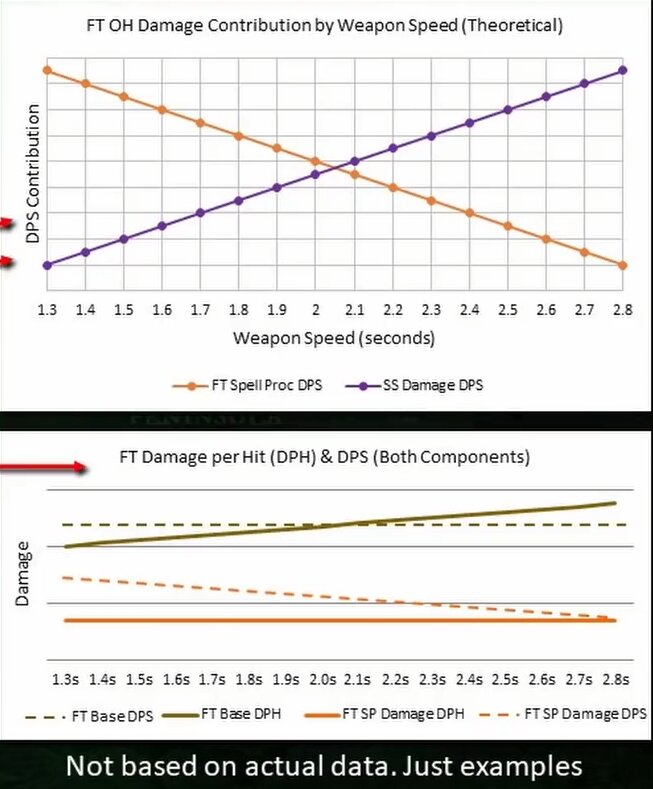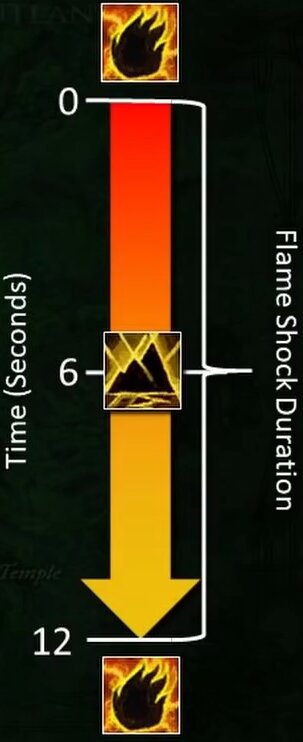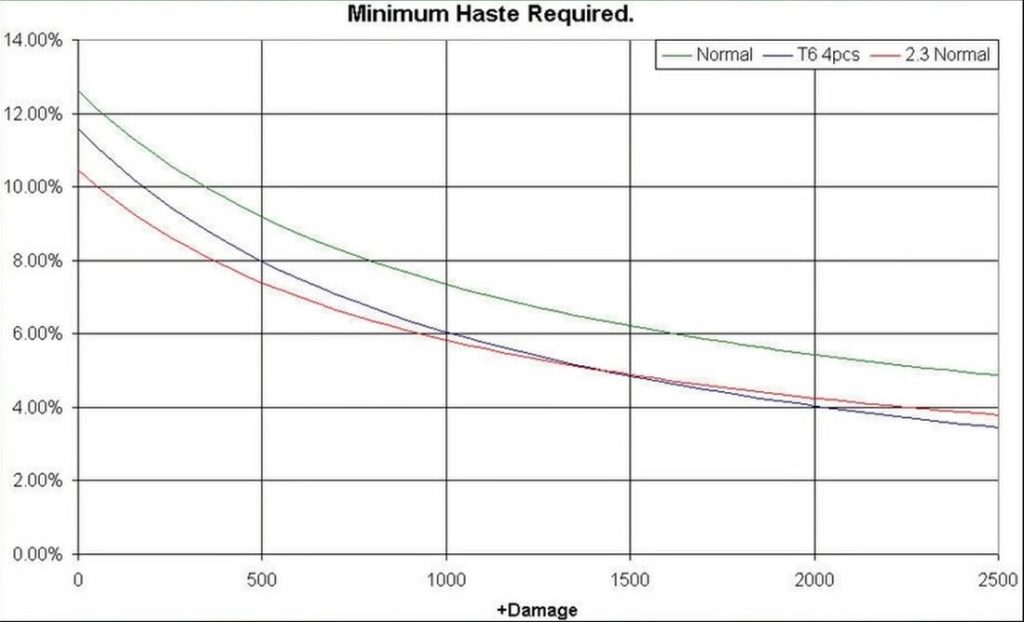- Author: Melderon
- Date: January 26, 2021
- Updated: April 1, 2025
- Expansion: TBC Classic
In this guide and the accompanying video, I will cover all advanced topics of the Shaman Class in Classic TBC including class changes, race/faction selection, new and advanced stats, spell coefficients, spec-specific theorycraft for Enhancement, Elemental, and Restoration; raid group composition and bloodlust/heroism strategy, addons and UI, threat, leveling theory, and stat priorities.
What is the Purpose of this Guide?
- This guide is not tailored as a general PvE Guide:
- I will not be going over basic things like enchants, gemming, talents, totem loadouts & pre-raid BIS
- I am in the process of making those types of guides as well and this data is ubiquitous.
- At the time of recording this guide, the Restoration PVE guide is already available (link in the description)
- Instead, this guide’s goal is to make you a more well-informed Shaman so you can make the “big picture” decisions and understand your class at a much deeper level. Hence, “Advanced”. Think of this as a graduate level course in Shaman.
- The theorycraft in this guide is built mostly for end-game PvE. However, you will learn information that will be helpful in PvP, leveling, and farming.
Enjoy! And if you have questions, find me on the Classic Shaman Discord (link in the References below)
Timestamps
- 00:00 Introduction & Table of Contents
- 05:53 Inherent Class Changes
- 09:22 Basic & Advanced Stats
- 22:19 Race/Faction Selection
- 29:47 Random Enchantment Gear
- 31:35 New Spells & Talents
- 47:37 Changes to Old Spells & Talents
- 1:01:44 Spell Coefficients & Downranking
- 1:15:55 Spell Coefficient Testing
- 1:33:00 Enhancement Theorycraft
- 2:15:05 Elemental Theorycraft
- 2:26:53 Restoration Theorycraft
- 2:42:22 Raid Composition & Strategy
- 2:48:08 Shaman Leveling in TBC
- 2:51:36 Aldor or Scryers?
- 2:55:06 UI & Addons
- 2:59:33 Conclusions & Additional Resources
Video References & Related Links
- Melderon’s Shaman Playlist: https://www.youtube.com/playlist?list=PLg0pEiKvlmUOaMt1Bzh_jiXBGlrtrFO9n
- Defcamp & Melderon TV links:
- YouTube Channel: https://www.youtube.com/c/defcamp&melderontv
- Defcamp on Twitch: https://www.twitch.tv/defcamp
- Elitist Jerks Enhancement Theorycraft: https://web.archive.org/web/20080811071236/http://elitistjerks.com/f47/t20765-shaman_enhancement/
- Elitist Jerks Elemental Theorycraft: https://web.archive.org/web/20080928080318/http://elitistjerks.com/f47/t20914-shaman_elemental/
- Elitist Jerks Restoration Theorycraft: https://web.archive.org/web/20080913121625/http://elitistjerks.com/f47/t24796-shaman_restoration/
- Classic WoW Downranking Tool: https://wowdownrank.ozgar.se/
- The Egregious Guide to TBC Restoration Shaman (Written): https://www.warcrafttavern.com/tbc/guides/the-egregious-tbc-resto-shaman-guide/
- The Egregious TBC Restoration Shaman Throughput and Efficiency Calculator: https://docs.google.com/spreadsheets/d/187Bg7MxwStZldbL1faFD3JXUMlgEBYmYd7G9uEaDcJI/
- Spell Coefficient Spreadsheet: https://docs.google.com/spreadsheets/d/10JEo2QobwjM4853D2YThkyCgzQZrdg-HBLdBFoA-CME/
- Weapon Imbue Testing Spreadsheet: https://docs.google.com/spreadsheets/d/1WhV0E_PpTVIvcN4qhPphJkdlOax44St8GfN8VTgQvxQ/
Classic Shaman Discord
Multidiscipline, collaborative home for all things Classic Shaman:
- Covers Vanilla Classic and TBC Classic
- Over 18,000 members, experienced and professional Moderators and Shaman Trainers
- Discussion on Spec-specific strategy, theorycraft, leveling, play improvements
- You can bother both Egregious and Melderon whenever you want!
Before We Proceed to Give You What You Need…
This is technically a new part in a series of videos on Classic WoW era Shaman. If I did not cover something you wanted me to, its extremely likely I already did in Advanced Shaman Guides 1 and 2, my Totem Guide, and/or my Advanced Leveling Guide. In a way, these are prerequisites to this video, and I am assuming you already have the knowledge of Classic Vanilla Shaman to proceed to TBC. Please watch these videos if you are lost with any topic!
— Melderon
A Disclaimer
This guide has been built using Theorycrafting and data from actual TBC (2007 and 2008). Most of the topics covered have been verified by multiple sources, including the Elitist Jerks (links to their Shaman pages are in the description of the video). Because of these facts, I am highly confident of the validity of the data and have spent over 100 hours researching and testing what is presented.
On spell coefficients and weapon imbues: The testing of spell coefficients and weapon imbues I present here were done using a 2.4.3 TBC repack, which is not an official Blizzard product. Despite this, almost all spell coefficients and weapon imbue results corroborate what has been tested by multiple TBC-era theorycrafters. However, until an official pre-patch, beta, and/or live TBC game has been released, I cannot be 100% sure the spell coefficients and weapon imbue results are completely correct. When I get access to an official client, I will upload a new video with my findings which will be called “TBC Classic Advanced Shaman Guide, Part 2”.
Table of Contents
- Inherent Class Changes
- Stat Offerings
- Race & Faction Choice
- New Random Enchantment Gear
- New Spells
- New Talents
- Changes to Old Talents/Spells
- Spell Coefficients & Downranking
- Spec Discussion & Theorycraft
- Shaman Raid Impact & Strategy
- Leveling Strategy
- Aldor or Scryers?
- UI and Addons
Inherent Class Changes
- Internal Windfury Weapon Cooldown
- 3 seconds!
- Cannot proc WF for 3 seconds after a proc has happened, even if dual wielding
- This cannot be circumvented by using multiple WF imbue ranks
- There is no ICD for Windfury Totem
- Prioritize slowest weapon possible (both main-hand and off-hand) if using double WF imbues
- 3 seconds!
- New Race & Faction: Draenei (Alliance only)
- Totem GCD reduced from 1.5 sec to 1 sec!
- Totems go under your character portrait and can be right-clicked to cancel the totem (no mana refund)
- Stat Changes (more below)
- Shaman Tanking reduced somewhat
- See Enhancement Spell Changes
- Weapon buffs extended to 30 minutes!
- 2-handed maces and axes learned from weapon master. No longer a talent in Enhancement
- New spells and/or ranks are available every level from 61-70
Stat Offerings
Basic Stats
- 1 Stamina = 10 Hit Points
- 1 Strength = 2 Attack Power
- Also increases the amount of damage you block with a shield by 1 per 23 Strength @60 and 21.4 Strength @70
- Agility:
- 20 Agi = 1% Melee Crit @60, 25 Agi = 1% Melee Crit @70
- 20 Agi = 1% Dodge @ 60, 25 Agi = 1% Dodge @70
- Also increases armor by 2 per 1 Agility regardless of level
- Spirit:
- Increases out of combat health regen by 1 health/sec per 8.6 Spirit @60 and 9.46 Spirit @70
- Increases out of combat and in combat mana regen by 1 mana/5 sec per 1.06 Spirit @60 and 1.58 Spirit @70
- Must be outside the 5 second rule!
- 1 Intellect = 15 mana (15.75 with 5/5 Ancestral Knowledge)
- Also increases Spell Critical Strike Chance at a rate of 1% per 30 Intellect@60 and per 41.1 Intellect @70
- This is somewhat disputed as Crit per Intellect was lower than expected in Vanilla Classic (around 30 compared to the believed value of 60.5)
- Intellect also gives Spell Damage & Healing at a rate of 0.3 per point with 3/3 Nature’s Blessing (Restoration)
- Also increases Spell Critical Strike Chance at a rate of 1% per 30 Intellect@60 and per 41.1 Intellect @70
Advanced & New Stats
- Haste (Spell & Melee):
- 10 rating = 1% Haste @60, 15.8 = 1% Haste @70
- Haste decreases the time between attacks/spells by affecting the GCD and/or cast time.
- Example: If you have 1% Haste, in the time it would take you to normally cast 100 spells, you can now cast 99
- Expertise Rating (Converted from Weapon Skill Rating in Patch 2.3):
- 3.9423 Expertise Rating = 1 Expertise = 0.25% reduction in chance to be dodged and parried
- 103 Expertise Rating (26.12 Expertise) = 6.25% dodge reduction (cap), 91 Expertise Rating (23 Expertise) if boss dodge is 5.6%
- 6.25% is the highest observed dodge. However, almost all mobs have a 5.6% chance to dodge, including bosses
- Note: Mobs cannot Dodge while casting
- Weapon Skill Rating (if using patch before 2.3): 2.5 = 1 Weapon Skill @60, 3.9 = 1 Weapon Skill @70 (This likely won’t be the case)
- An easy way to understand Expertise:
- The 5 expertise from racials leads to: 2.5% more Yellow + White connects if attacking from the front. 1.25% more Yellow + White connects if attacking from the rear. Works the same in PvP! Weapon racials not as impactful as in Vanilla but still impactful for Enhancement & Shaman Tanking.
- Hit Rating: 10 = 1% Hit @60, 15.8 = 1% Hit @70
- Melee Hit Rating/Hit Conversion: Hit% = Hit Rating/15.8
- Spell Hit Rating: 8 = 1% Hit @60, 12.6 = 1% Hit @70
- Spell Hit Rating/Hit Conversion: Hit% = Hit Rating/12.6
- Hit Cap* for casters is 16% (201.6 hit rating). PvP spell hit cap is 3% (47.4 hit rating)
- Caster Hit cap is actually 17%. However, you can never achieve this no matter how much hit you have.
You will always have a 1% chance to miss
- Critical Strike Rating (Spell & Melee): 14 = 1% Crit @60, 22.1 = 1% Crit @70
- Resilience: 39.4 = 1% less chance to be critically struck & 2% less damage from critical strikes
- Armor Penetration (ArP): A stat that ignores a percentage of the armor of your opponent.
- This stat provides a personal buff that has increasing returns, not diminishing returns
- This Equation is used to calculate ArP: Boss Armor/Boss Armor – 22167.5 + 467.5 * Attacker Level
- Example: If a boss has 2000 Armor, then the boss has 2000/(2000 – 22167.5 + 467.5 * 70) = 15.9% physical damage reduction
- 200 ArP would reduce the armor to 1800 Armor. This leads to 1800/(1800 – 22167.5 + 467.5 * 70) = 14.6% physical Damage Reduction, an increase in damage of 1.3%
- Another 200 ArP would lead to 1600/(1600 – 22167.5 + 467.5 * 70) = 13.2% physical damage reduction, an increase in damage of 1.4%
- Spell Penetration: Not generally applicable in PvE as bosses may have inherit resistances that cannot be mitigated. Moreover, elemental resistances were heavily reduced in TBC.
- 70 Spell Penetration is usually recommended for PvP as it negates resistances from defensive spells like Mark of the Wild
- Spell Penetration has nothing to do with % Hit!
- Healing Gear provides approximately 33% of the healing spell power as chromatic damage (non-elemental based damage)
- Allows Healers to do some farming in their healing gear or more effectively PvP!
- Defense Skill Ratings:
- @ Level 60:
- 1.5 Defense Skill Rating = 1 Defense Skill; 12 Dodge Rating = 1% Dodge; 20 Parry Rating = 1% Parry; 5 Block Rating = 1% Block Chance
- @ Level 70:
- 2.4 Defense Skill Rating = 1 Defense Skill (415 Defense skill [154 Defense Rating] = defense cap (cannot be critically struck by a boss); 18.9 Dodge Rating = 1% Dodge; 31.5 Parry Rating = 1% Parry; 7.9 Block Rating = 1% Block Chance
- @ Level 60:
Glancing Blows
TLDR: Weapon expertise/skill racials are not as meaningful in TBC as in Vanilla
- Glancing Blows still exist in TBC.
- You only have a 25% chance to glance on bosses (level 73)
- Normalized for all classes
- This was enacting in patch 2.1.0
- Prior to this, glances happened at 40% with caster classes glancing 60% (on bosses) if attempting to melee
- Glancing blows do not critically strike and cannot occur on special (yellow) attacks
- 0% chance to glance on a mob that’s your level or lower
- You only have a 25% chance to glance on bosses (level 73)
- Expertise (and Weapon Skill past 2.0.1) does not reduce the glancing damage penalty
- Glancing penalty is between 30-40% on bosses
- Weapon skill still exists and before level 70 will dictate miss, chance to be parried, and chance to be dodged
- Once you get to max weapon skill, %hit, %dodge, and %parry reaches its natural cap
- Only Hit rating (+Hit) and expertise rating (+Expertise) can affect them further
- So, before you enter a raid or high-level content, make sure your weapon skills are at 350 if playing enhancement!
- Once you get to max weapon skill, %hit, %dodge, and %parry reaches its natural cap
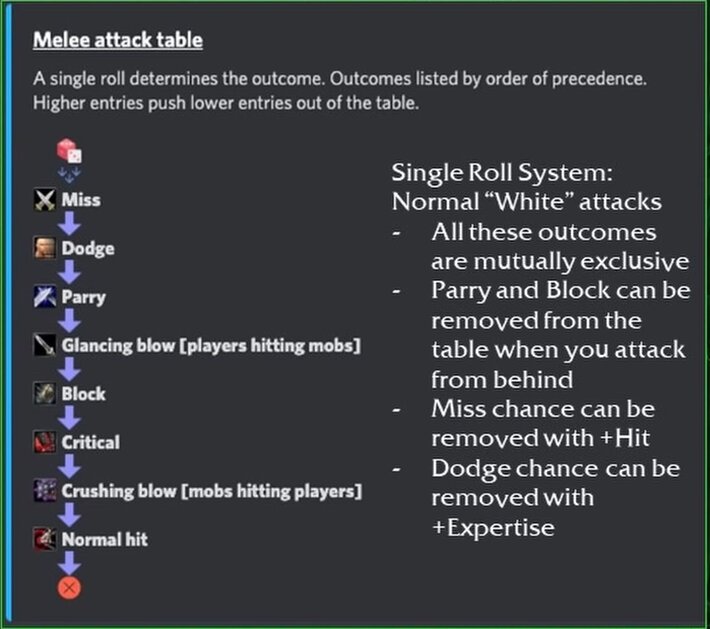
Race/Faction Selection
Orcs – Relevant Racials
- Axe Specialization: increases Expertise with Axes by 5
- 1.25% reduction in dodge chance (from behind)
- 1.25% dodge and 1.25% parry reduction (from front)
- Good for Enhancement
- Hardiness: Chance to resist Stun effects by an additional 15%
- Down from 25% 🙁
- Blood Fury: Increases AP by 242/282 (level 60/level 70) and spell damage/healing* 123/143 for 15 secs (level 60/level 70)
- *Needs to be confirmed; different tooltips float around
- Also reduces ALL healing on you by 50% for the duration!
- Good for all specs but best for Enhancement!
Rundown: Best for Enhancement PvE & General PvP. Likely BIS for Elemental and 2nd best for Restoration PvE.
Trolls – Relevant Racials
- Berserking: Increases casting and attack speed by 10% – 30% depending on health (lower health, higher haste)
- Good for DPS and Healing
- Pair with Bloodlust
- 91 mana cost @60; 177 @70
- Beast Slaying: Increases damage vs beasts by 5%
- Good for leveling/grinding
- Regeneration: Increases Spirit-based health regeneration by 10% and allows 10% of that regen in combat.
Rundown: Best for Restoration PvE, great alternative for Enhancement/Elemental PvE, average for PvP.
Tauren – Relevant Racials
- War Stomp: Stuns up to 5 enemies in 8 yards for 2 secs.
- Useful for trash mobs or in PvP to create devastating combos or recovery
- Endurance: Total Health increased by 5%
- Good in every situation and requires no user input
- Cultivation: Herbalism skill increased by 15
- Good for farming gold
- Nature Resistance: Increases Nature Resistance by 10
- Only useful in rare circumstances or in PvP against Druids and other Shaman
Rundown: Mediocre for PvE roles. Good in PvP, especially if you want control when you have the advantage (War Stomp)!
Draenei – Relevant Racials
- Inspiring Presence: Grants 1% spell hit for you and your party members
- Extremely useful for your caster core in early tiers, removing 1% hit from the gear they and you need to cap. Outscaled in later tiers
- Gemcutting: Jewelcrafting skill increased by 5
- Good for leveling Jewelcrafting/getting rarer gems (prospecting)
- Gift of the Naaru: Heals your target or yourself for 187 every 3 secs for 15 secs (935 health) @ level 60. Level 70: 217 healed every 3 seconds (1,085 health total)
- 100% Spell Coefficient (110% with 5/5 Purification)
- No mana cost and school-”less” (great kick bait)
- Good racial for any circumstance (especially for Shaman as we have no HOTs outside of Earth Shield)
- Downsides: 1.5 sec cast time, long CD, and low base
- Shadow Resistance: Increases Shadow Resistance by 10
- Only useful in rare circumstances in PvE or in PvP against Shadow Priests and Warlocks
Rundown: Only choice on Alliance for Shaman but have racials that shine in many facets of TBC. (Bonus: Unique Totem models!)
Random Enchantments
Old Random Enchantments
All of these exist in TBC and can drop in Outland as well as in Azeroth, except the Abyssal pieces (only in Silithus/AQ)
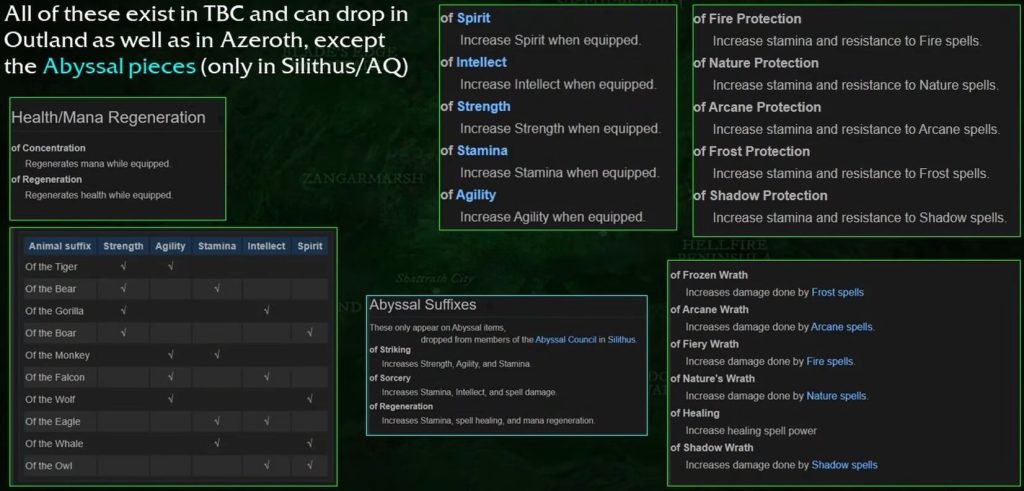
New Random Enchantments – TBC
Modifiers on items have very specific drop rules. The suffixes such as Physician and Prophet will only be found on Cloth gear. Other ones like Hierophant will only drop as Leather gear. Bandit will drop as Leather and Mail gear to facilitate the classes that would most benefit from it. The drop rates are also widely variable. The more standard types such as Beast and Sorcerer will drop quite frequently, while more obscure suffixes like Knight are very rare, and will only drop as Rare quality (Blue) gear.
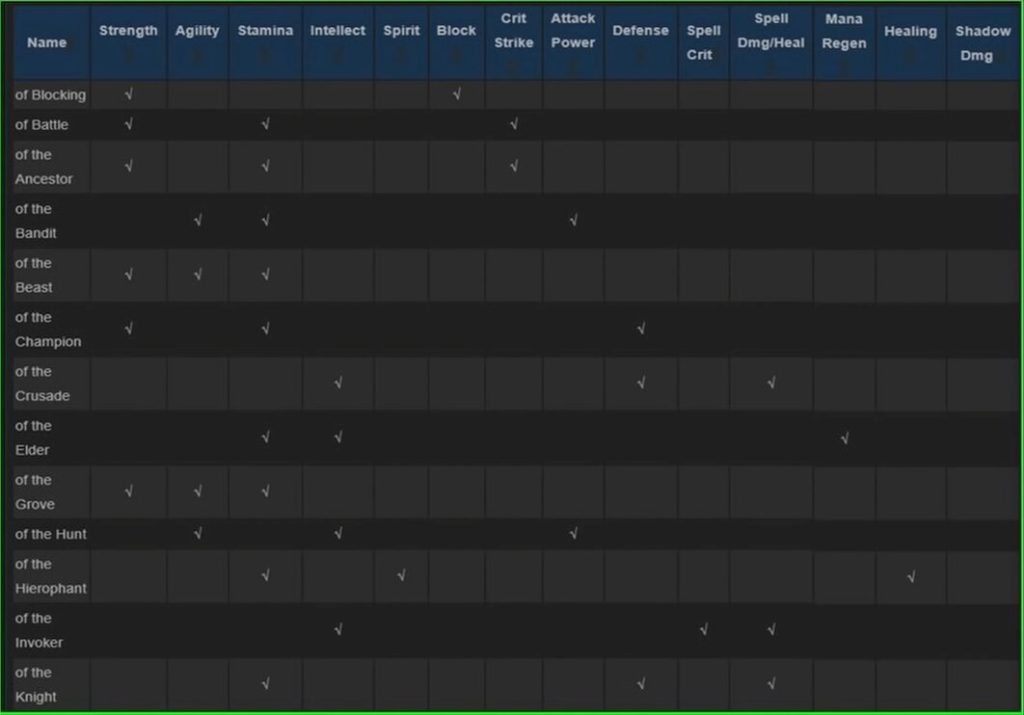
You will notice that some suffixes add the same stats. These are differentiated by the amount of each stat available on the piece of gear, based on which stat is emphasized.
These pieces only drop in the new starting zones, Outland, Karazhan, ZA, and the Isle of Quel’Danas (i.e., TBC Content).
New Talents & Spells
New Universal Shaman Spells
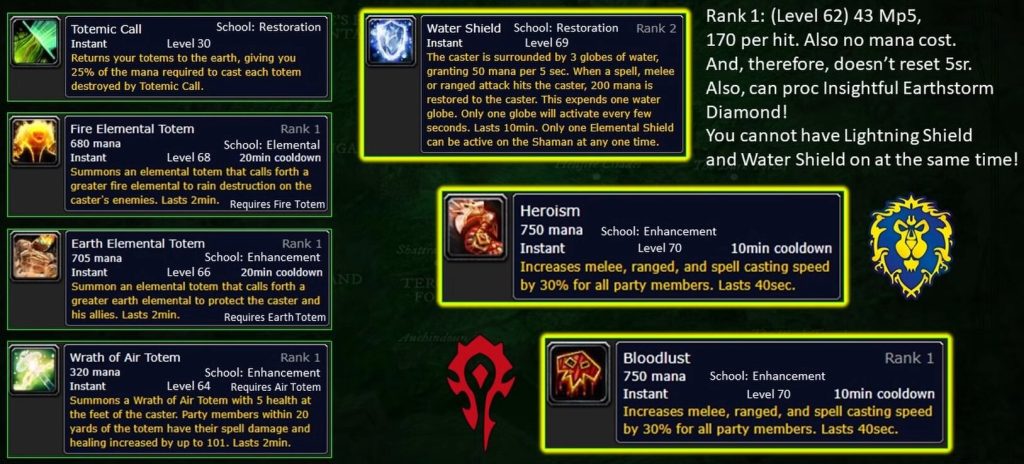
Elemental Talents & Spells
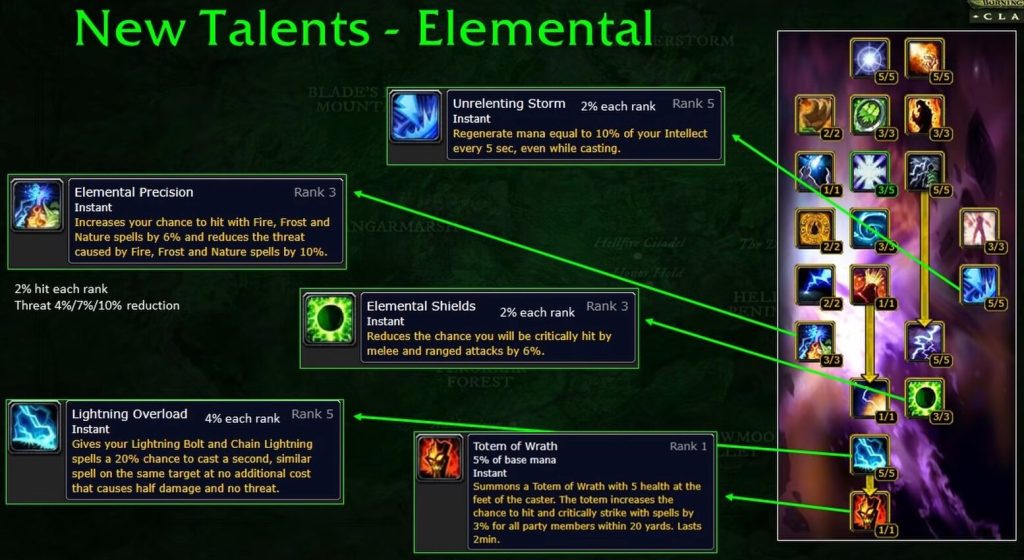
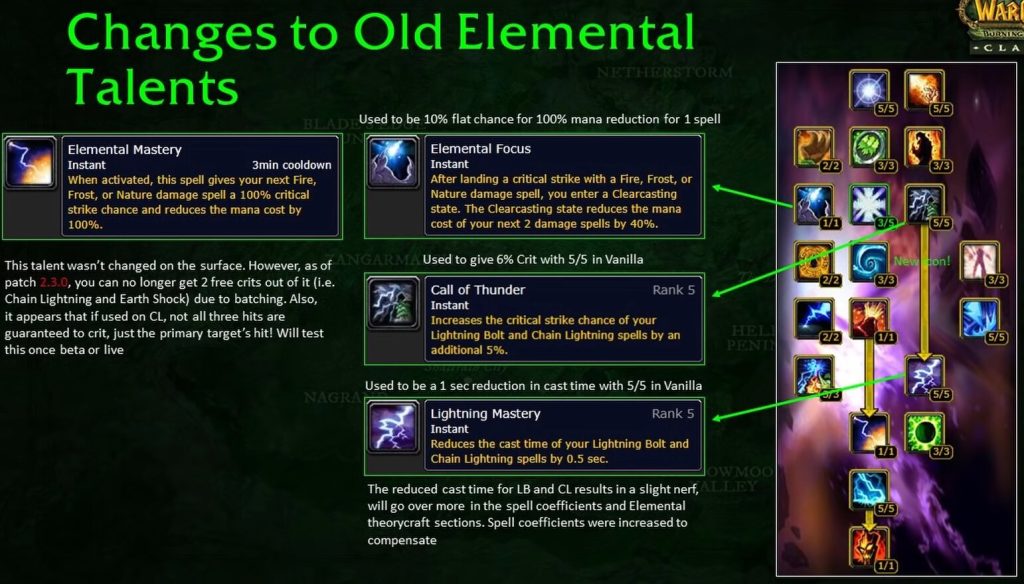
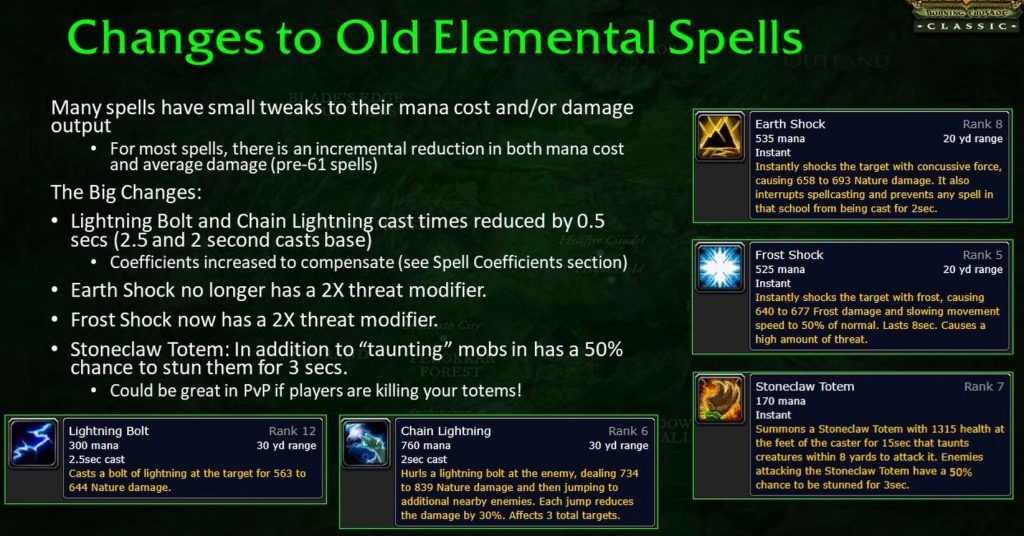
Enhancement Talents & Spells
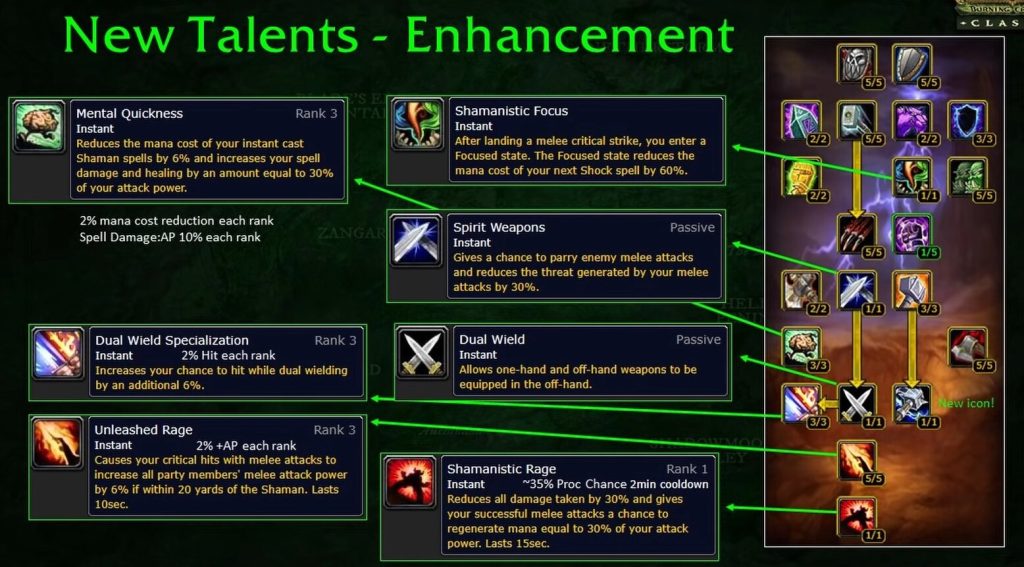
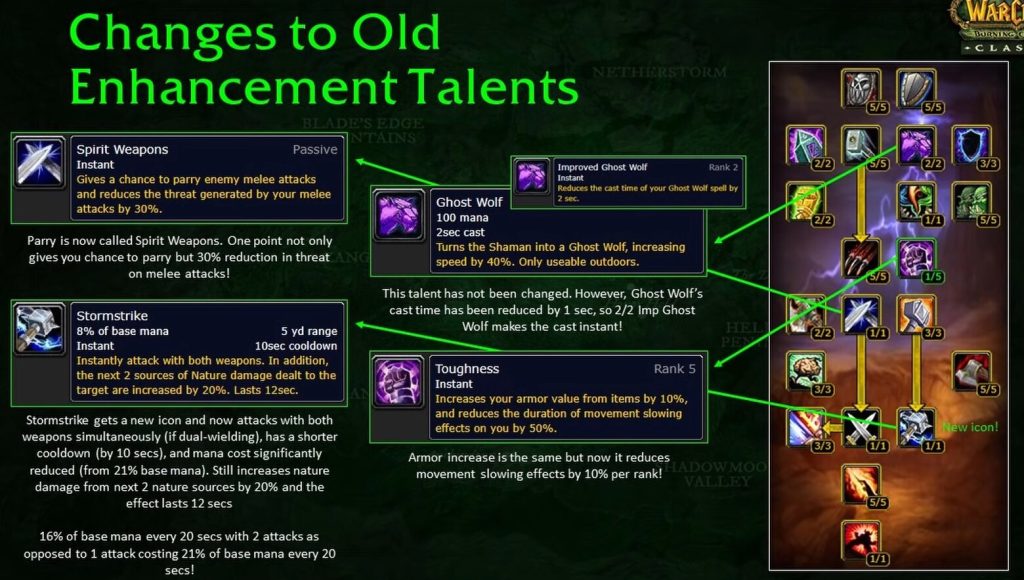
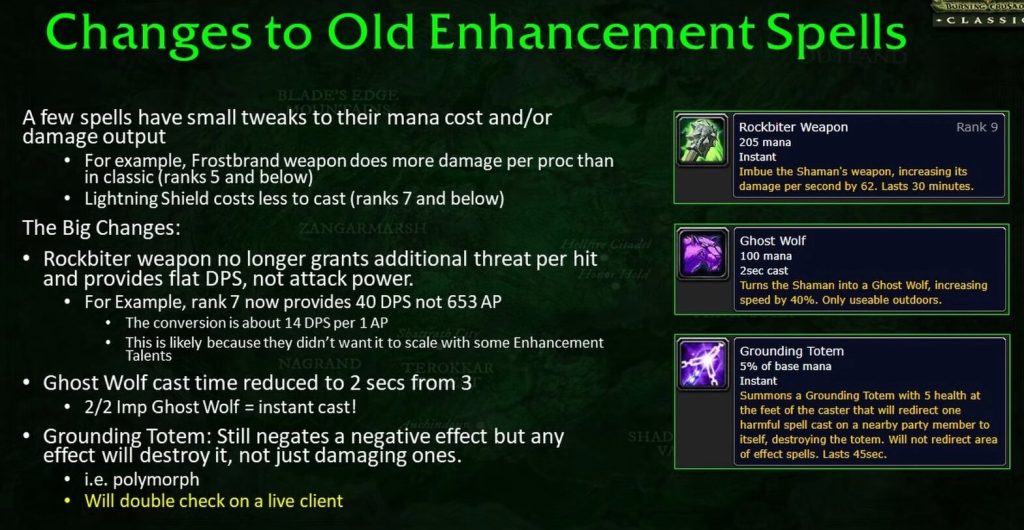
Restoration Talents & Spells
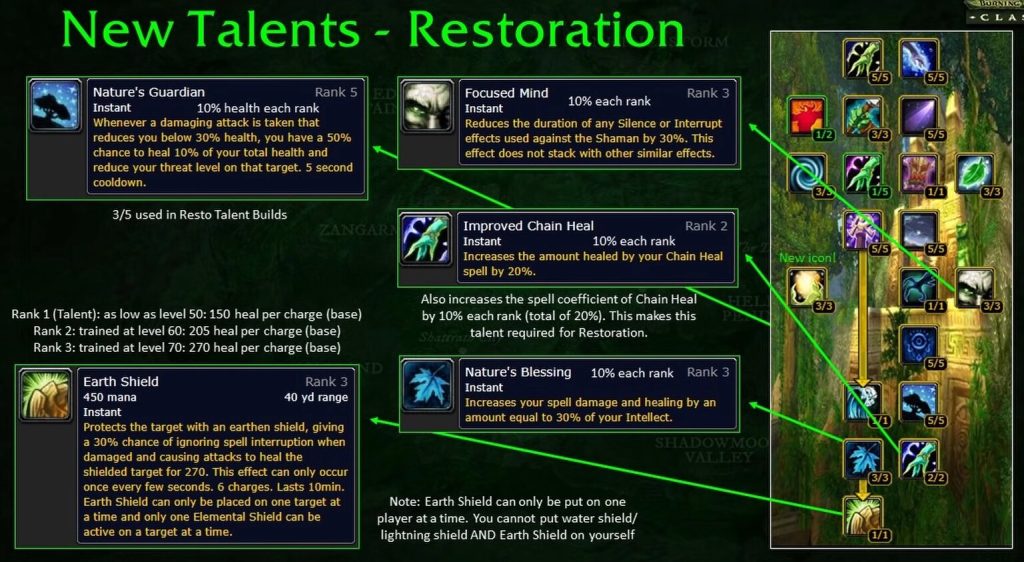
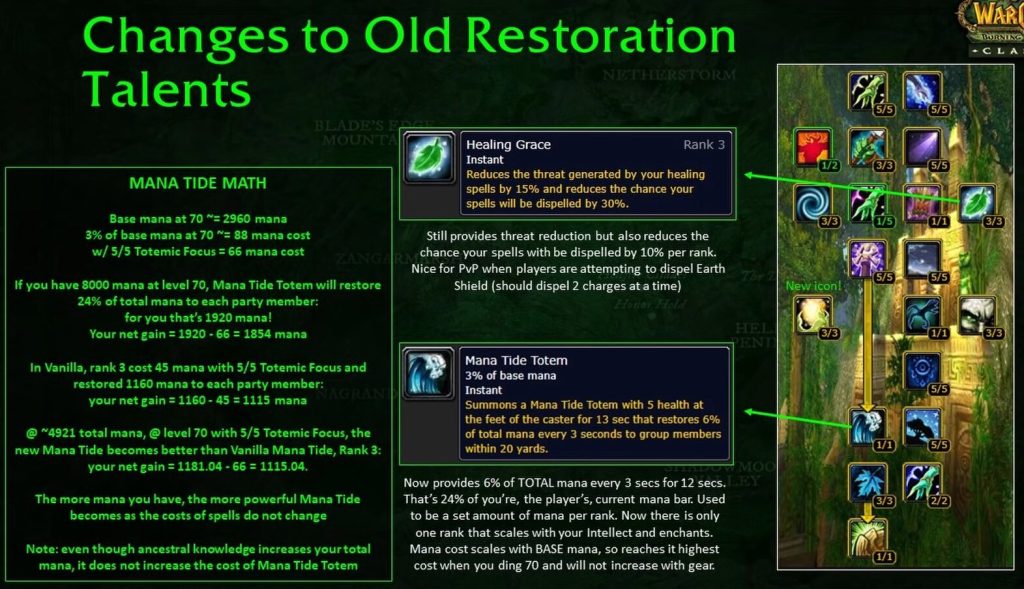
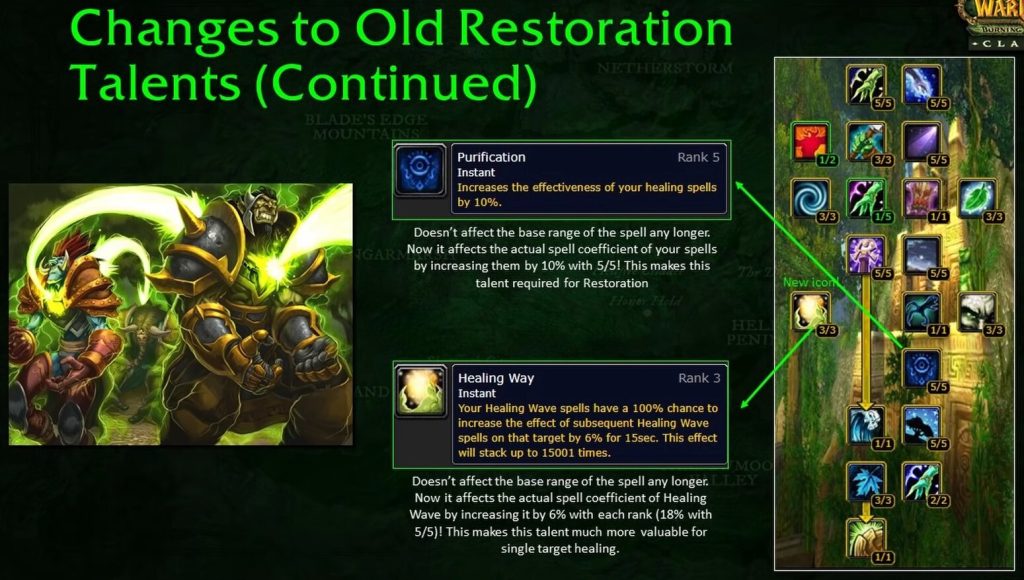
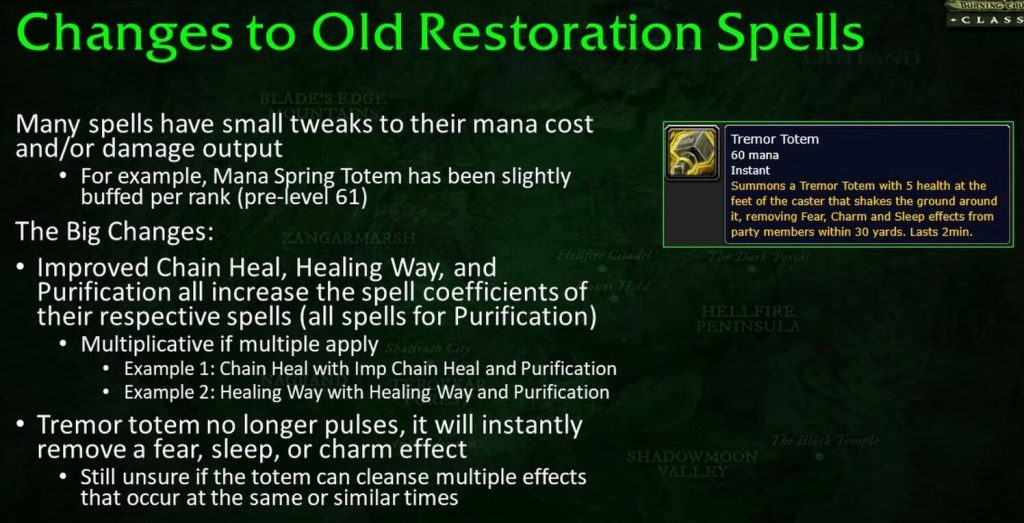
Spell Coefficients & Downranking
Understanding Spell Coefficients
Which piece of gear provides the most spell power? (Ignore other stats.)
The answer is…
They both provide the same amount of bonus spell power!
- As a Shaman, not all your bonus spell power and/or healing goes to your spells
- Spells interact with spell power through what is called a spell coefficient
- Spell coefficients are usually calculated from spell cast times
- Example, Healing Wave, Rank 12
- 3 second base cast: 3/3.5 (3.5 secs is the Reference Cast Time) = 0.8571 (86%)
- If you have 1000 healing power, only 857 will go to Healing Wave
- Average Healing Wave heal = 2286
- New Average w/ 1000 healing: 2286 + 857 = 3143
- Example, Healing Wave, Rank 12
- I will not go over how to calculate other spell coefficients in this guide.
- If you want to understand spell coefficients and downranking better, watch my downranking video (link in the References section at the top)
- Note: the video was made for Vanilla Classic and there is no Downranking Penalty (see next section)
Downranking Changes
TBC introduces a second penalty to downranking in addition to pre-20. This is in place for all classes with mana, not just Shaman.
- Known as the Downranking Penalty (DRP)
- Significantly penalizes lower ranks of spells
- Penalty depends on the difference between trained level and the current level
- Equation (calculated for each rank):
- DRP = (level rank was trained + 11)/current level
- If DRP ≥ 1, there is no penalty
- If the rank is learned before level 20, and the DRP < 1, then you multiply both penalties
- You multiply all penalties by the known spell coefficient of the spell!
- Examples with Healing Wave are to the right
- DRP = (level rank was trained + 11)/current level
- Ozgar and I are in the process of creating a new tool for TBC to calculate HpME and HpS in terms of the DRP
- Example with no pre-20 penalty: Healing Wave, Rank 6 (learned at level 32) casting @ level 70:
- (0.8571)((32 + 11)/70) = 0.5265 (52.65%)
- Example with pre-20 penalty: Healing Wave, Rank 3 (learned at level 12) casting @ level 70:
- (0.7143)(1-((20-12)*0.0375))((12 + 11)/70) = 0.1643 (16.43%)
- Remember, since Healing Wave, Rank 3’s base cast time is 2.5 seconds, the base coefficient is 0.7143 (2.5/3.5), not 0.8571 (3/3.5)
- Example with no penalty: Healing Wave, Rank 11 (learned at level 63) casting @level 70:
- (63+11)/70) = 1.05 (DRP ≥ 1, so no penalty!)
- Notice I did not multiply the spell coefficient (0.8571) because the DRP equation yields a number greater than 1
- No reason to go further. If you did, you would get a number greater than 0.8571 (0.9061).
- You cannot increase your spell coefficient outside of certain talents (i.e., Purification)!
Effects of Downranking Penalty
Due to the Downranking Penalty, using lower ranks will lead to significant drops in mana efficiency (HpME) unless you have a lot of spell power. Remember, higher ranks will always have higher HPS compared to lower ranks!
Use the example below with Healing Wave to better understand:
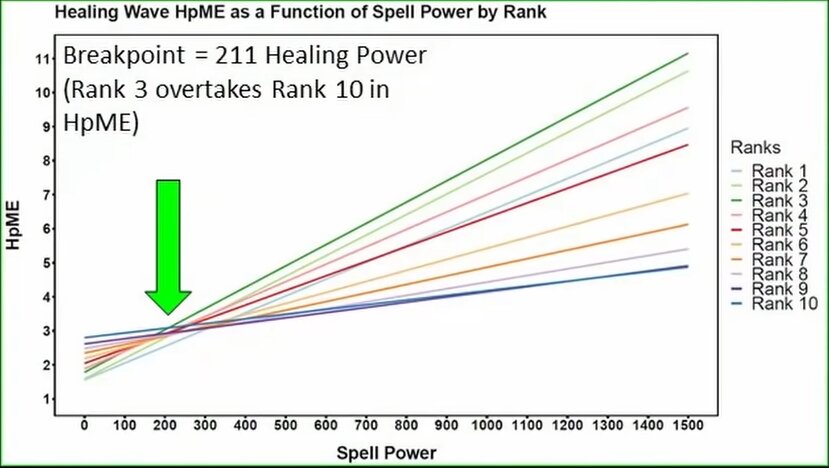
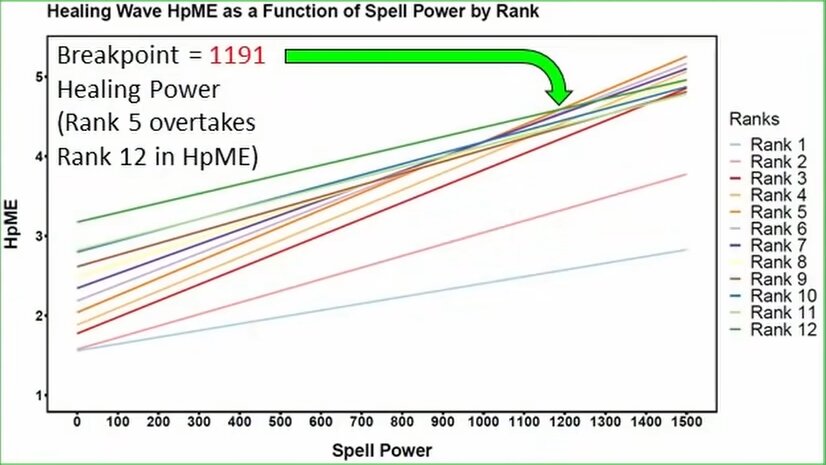
More examples:
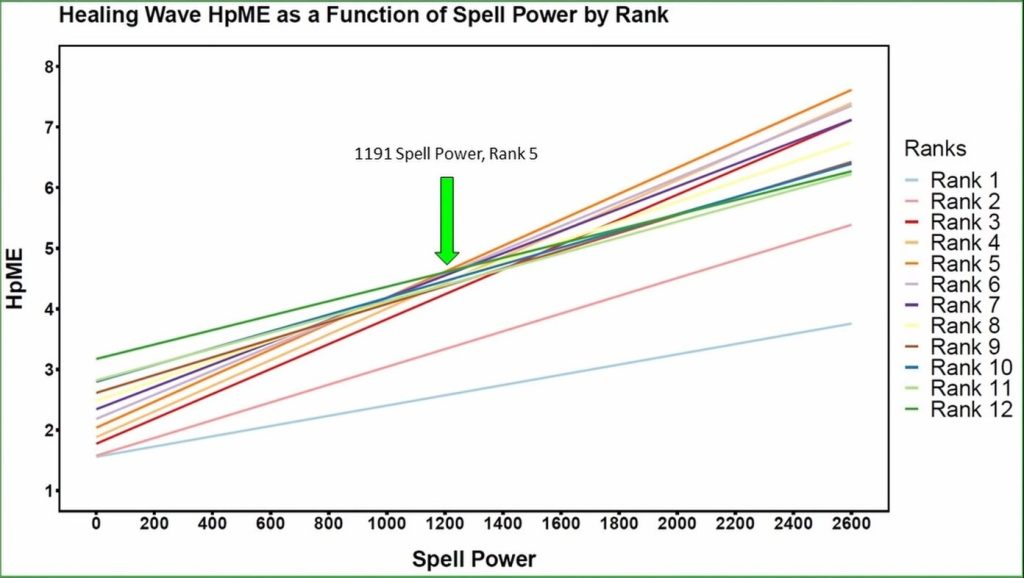
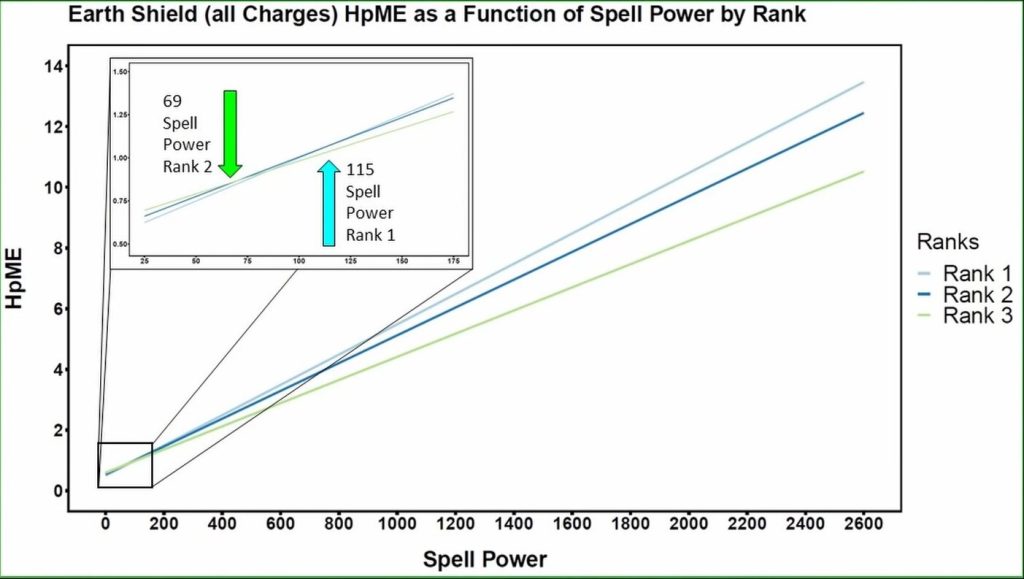
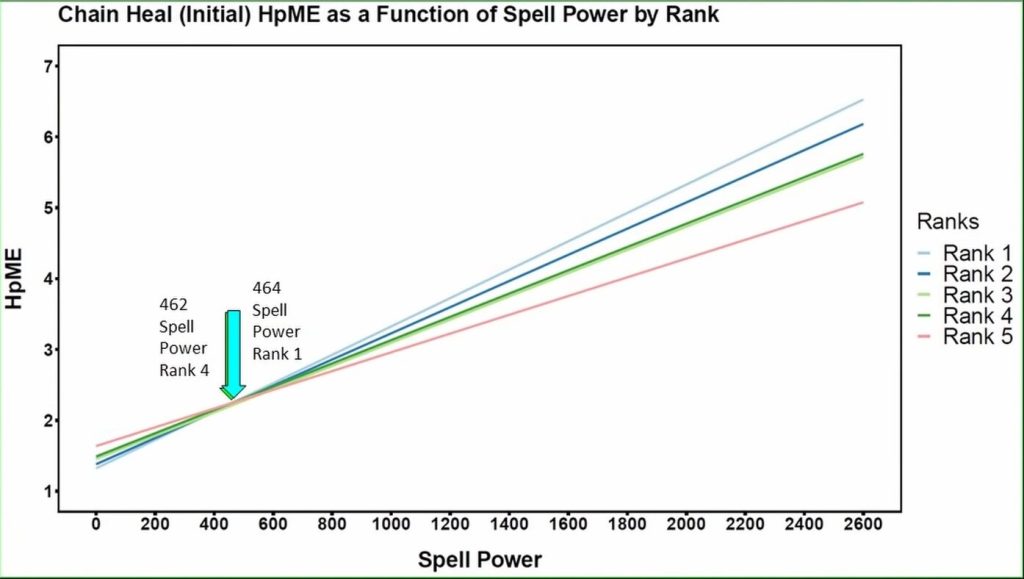
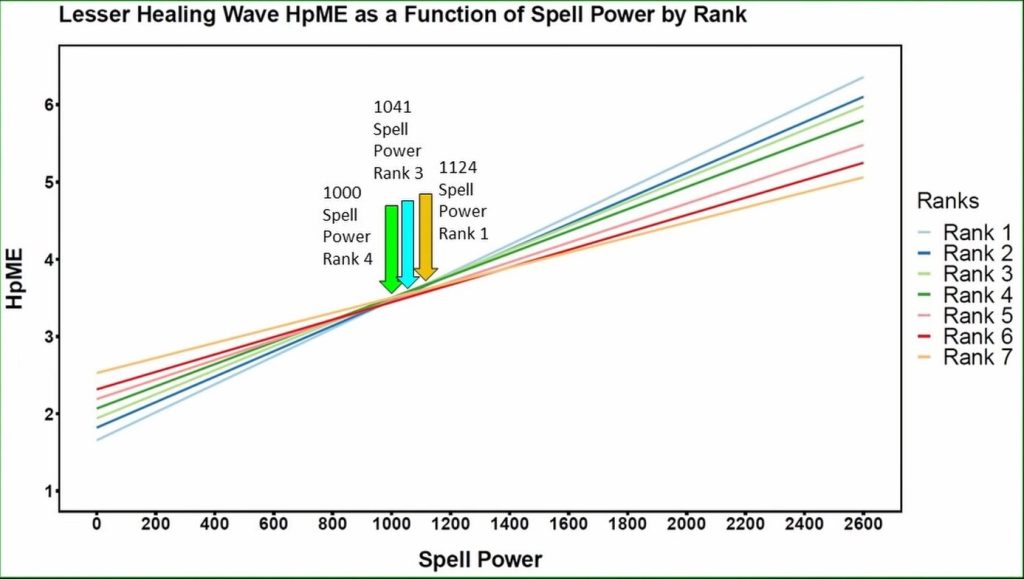
Are Lower Ranks Better Than Higher Ranks?
Short Answer: It Depends.
- Just because a low rank becomes more mana-efficient due to increase in spell power, it doesn’t make it “better” than a higher ranked spell
- HpME inflations occur because of how small the effect ranges are on low rank spells
- Spell power affects them at a greater rate, increasing their healing per mana relationships significantly
- Higher ranks will always produce more Healing per Second (HPS) than a lower rank
- But all that healing may not be needed in every circumstance
- This is where lower rank heals shine as they are cheaper
Exam Question 1: Your tank is about to die but so is the boss. You only have 500 mana left. Do you cast Healing Wave, Rank 8 (B) or Healing Wave, Rank 5 (A)?
Answer: B.) Rank 8. You have no idea what could happen in the next few seconds. Your tank could be crushed or crit and Rank 5, even though it’s the most mana efficient, may not be enough to save him. Use the higher rank!
Exam Question 2: A melee in your group made a stupid mistake and stood in fire briefly. He likely won’t do it again. He only needs 400 health to cap. Which rank will you use?
Answer: A.) Rank 5. In this circumstance, there is no reason to expend the extra mana as it will result in a significant overheal (waste of mana). In this circumstance, the lower rank is far better.
Should I Downrank in TBC Classic?
Short Answer: Yes.
- Even though downranking has been nerfed, remember, lower ranks will always cost less mana.
- The more spell power you have, the more mana efficient downranking becomes
- We will get into specific downranking recommendations for heals in the Restoration theorycraft section
- It is very important to remember that HpME is not the end all be all, HPS is also extremely important when healing
- Never use a rank just because it’s the most mana efficient. Outputting as much healing as possible while also being mana efficient should be your goal!
- Lower ranks, excluding early ranks of HW, do not have lower cast times. You need to optimize how much healing you put out in each window of time. Do not just focus on mana efficiency!
- Side Note: Downranking Earth Shield is usually a bad idea (More in Restoration Theorycraft Section)
- You should not downrank damaging spells unless you are dangerously low on mana. Higher ranks will always have higher DPS
- Elemental Shaman can use water shield and keep up Elemental Focus much more in TBC
- Because of these factors, and consumables, you should not have mana issues if you use the correct rotation. (more on this in elemental theorycraft section)
- Enhancement Shaman can also use Water Shield and have Shamanistic Rage to regen large amounts of mana.
- Elemental Shaman can use water shield and keep up Elemental Focus much more in TBC
TBC Spell Coefficient Testing
Spell Coefficients Spreadsheet: https://docs.google.com/spreadsheets/d/10JEo2QobwjM4853D2YThkyCgzQZrdg-HBLdBFoA-CME/
Another Disclaimer: Remember, these coefficients have been calculated using a TBC repack – not a Blizzard product. I will be retesting all of these on a prepatch, beta, and/or the actual game. Please be on the lookout for Classic TBC Advanced Shaman Guide, Part 2 for updated values. I suspect some of these coefficients to change in actual TBC Classic. Coefficients are impossible to 100% confirm on a TBC repack as they are solely based on available theorycraft we had at the time the game was live.
— Melderon
Check out the Spell Coefficient Testing section in the video where I highlight interesting details and go over the specifics.
Spec-Specific Theorycraft
Most of the points discussed here come from two sources:
- The Elitist Jerks web archives from actual live TBC
- Personal correspondence with spec experts and private server veterans on the Shaman Discord
It is important to note that metas may shift and change upon TBC Classic’s release and observations made in endgame PvE/PvP
- Private servers sometimes get things wrong!
Enhancement Theorycraft Overview
- PvE DPS revolves around dual-wielding to produce the maximum possible DPS
- Weapon Imbue selection depends on several factors (discussed later)
- Totem twisting in melee group between Windfury Totem and Grace of Air Totem provides the most benefit and utility
- Also, 100% up-time on Strength of Earth Totem
- Shocks and Stormstrike will fill up downtime between twisting resets. Perform both on CD!
- Passive Unleashed Rage Procs will also boost your fellow melee
- Mana Management with Mana Spring Totem, Water Shield, and Shamanistic Rage will help you maintain DPS and twisting
- Never let Mana Shield/MST lapse!
Weapon Imbues
- Rockbiter weapon provides consistent DPS increase that is not subject to RNG or outside modifiers (spell power and/or attack power)
- Good for leveling and perhaps very early PvE
- Flametongue weapon damage scales with spell power (via Mental Quickness) and provides consistent DPS increase with each swing
- Is on the melee hit table but can be resisted or partially resisted like a spell
- Frostbrand weapon damage also scales with spell power (via Mental Quickness). However, its uptime is approximately 9 ppm, so variable throughput
- Also, applies a slow and can be resisted as with Flametongue. Not many applications
- Windfury weapon provides a 20% chance* on swing to grant 2 extra attacks with bonus AP. Obviously, this means its variable. This is limited by the 3 sec ICD.
- This is the only imbue that scales with weapon damage itself. Therefore, has a higher potential damage ceiling
- *May be as high as 36% when DWing (see section below)
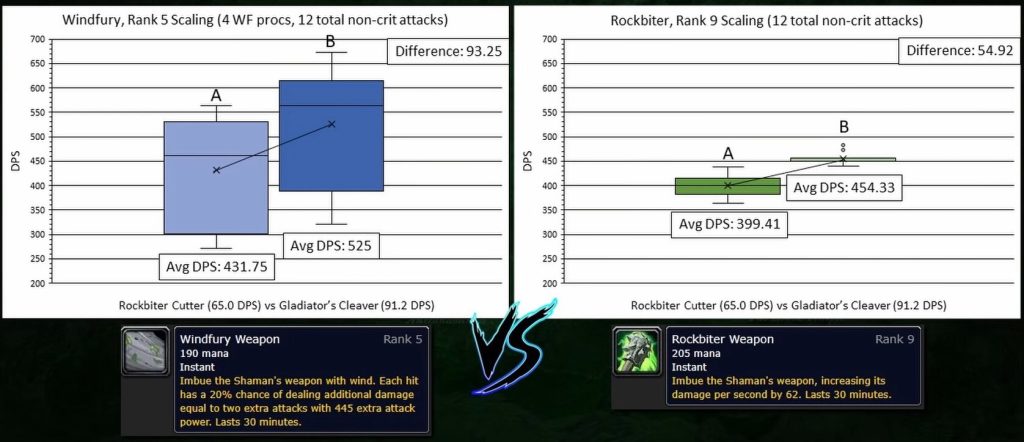
2-Hander or DW?
- A Common misconception is that since 2-handed weapons have higher top ends, Stormstrike hits significantly harder when using a 2-hander
- Elitist Jerks have calculated a comparison with 1500 AP:
- Season 3 2H: 868.83 average Stormstrike damage: (134.2 + (1500/14)) X 3.6 = 868.83
- 2 X Season 3 1Hs = 819.94 average Stormstrike Damage: (103.1 + (1500/14) X 2.6) + ((103.1 + (1500/14) X 2.6)/2) = 819.94
- 2H is higher but not by much
- More importantly, DW provides higher uptimes of Flurry, Windfury (if double imbued) and Unleashed Rage and benefits more from +Hit (specials are already capped trough talents)
- With these aspects added, DW far outweighs the higher top end damage of a 2Hander
- Elitist Jerks have calculated a comparison with 1500 AP:
- In PvP, however, there are definite applications for 2-Handers
- Low armor targets w/ Windfury procs
- Finishing off low health targets
- Timing burst windows
- Because of these, you should have an imbued 2-H at the ready in arena
Which Imbue for Raiding?
- PvE Imbuing comes down to two possibilities:
- Double WF
- WF Main Hand & FT Off Hand
- Double WF (WF/WF) is highly contingent upon weapon speed
- As a rule, if using WF, you want the slowest weapons possible, both main hand and off hand
- This is because, the faster your offhand is, the more likely it will “steal” WF procs
- Remember, there is a 3 sec ICD for Windfury, so the faster your offhand is, the more likely that the next WF will come from it instead of your MH
- This is not optimal because off hand attacks suffer a damage penalty and slower weapons produce higher WF damage. Therefore, creating a suboptimal WF proc.
- The only way to reduce this is to have the slowest off hand possible while also having the slowest main hand possible (2.6-2.8 seconds) as per the graph below
- Usually finding the slowest main hand possible (2.6-2.8 seconds) isn’t challenging. However, slow off hands are harder to come by.
- And don’t even think about using WF totem to escape the ICD! 1 extra attack vs 2 extra attacks is not worth it!
- Additionally, using multiple WF weapon ranks will not break the ICD
- As a rule, if using WF, you want the slowest weapons possible, both main hand and off hand
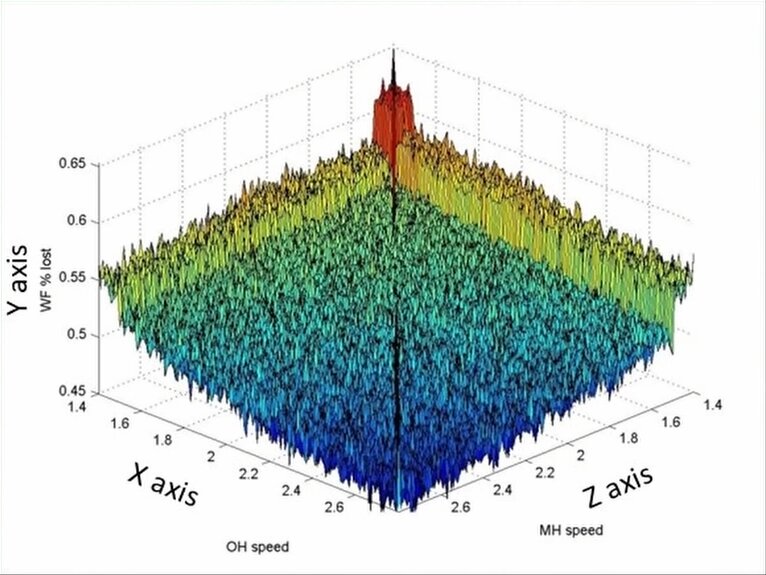
Double WF’s 36% Proc “Feature”
- There is a curious thing that occurred throughout of all of TBC concerning double WF imbuing.
- If DWing and both weapons are imbued with WF, then the chance that a successful melee attack outside of the 3-second ICD procs WF is 36%, not 20%
- To clarify, when both weapons are imbued with WF, the chance for the main hand to proc is 36% and the chance for the offhand to proc is 36%
- It is important to note that this is not a statistical theory trying to extrapolate the combined WF proc chance due to DWing
- It is a feature/bug that was never rectified in all of TBC but was fixed sometime in WOTLK
- Whether it will be in Classic TBC is anyone’s guess at this point
WF/FT Mixed Imbue FT OH Damage Contribution by Weapon Speed (Theoretical)
There are 3 reasons why WF/FT may be superior to WF/WF:
- If the 36% feature is not in TBC, WF/FT may surpass WF/WF in overall DPS
- FT is speed agnostic due to slower weapons contributing more to Stormstrike, faster weapons receiving more from spell power per unit time (FT damage portion scales with weapon speed but SP portion does not), and the fact that it can’t “steal” a WF proc. The damage is “safer” and more consistent
- This allows the player to pick the best OH option without being concerned about weapon speed
- Mental Quickness was buffed in patch 2.3 to provide more spell power from AP (30% of current AP). Since it was later in TBC, most theorycraft had already moved on
WF/FT Comparisons
Head to the main video to see full comparisons (ANOVAs) of WF/WF and WF/FT for slow and fast 1-handers.
Summary of the results:
- WF/WF Slow, WF/FT Slow, and WF/FT Slow MH/Fast OH have the highest DPS and are not significantly different from each other (α = 0.05)
- Will require further testing in raids to determine if there is a clear winner
- WF/FT Slow and WF/FT Slow MH/Fast OH show that OH speed doesn’t matter as long as a slow MH with WF is used
- Again, FT is mostly speed agnostic due to the trade-offs between FT spell damage/sec and SS weapon DPS contribution
- This means that likely, if you get a fast OH weapon in a raid, you could use it with FT without sacrificing DPS output
- WF/WF Fast is lowest possible DPS, most of the time significantly so
- Fast OH weapons with WF have significant detrimental effects on DPS due to WF proc stealing
- If you are stuck with 2 fast weapons, use WF/FT (however, this is not optimal)
- May require players to use weapons with less DPS (lower ilvl) if it is slow as the benefits of a slow MH outweigh the DPS increase that a faster one with a higher ilvl has
- WF/WF, at least with the parameters tested, doesn’t out scale WF/FT
- Despite a large jump in weapon DPS, WF/WF and WF/FT relationships remain statistically similar
- Further testing is required to determine if this will be in the case in live TBC
- Despite a large jump in weapon DPS, WF/WF and WF/FT relationships remain statistically similar
- WF/FT is more variable than WF/WF
- This is likely occurring for two possible reasons:
- 1. There is sampling error, or
- 2. WF procs are more consistent with WF/WF. Meaning that my client did code the 36% WF/WF feature. FT should be more consistent
- This is likely occurring for two possible reasons:
WF->FT OH Speed Breakpoint?
- The results show that WF/FT is speed agnostic while WF/WF requires a slow weapon. But what does slow mean?
- The good news is that, in endgame TBC, weapons that fall within the middle category (2.0-2.4) are very rare. This is because DWing classes want one or the other and the game was itemized with that in mind.
- However, if you find yourself stuck with a potential upgrade that falls in the middle speed category, you can do one of two things:
- 1. Just use FT since its speed agnostic, or
- 2. If you are hellbent on WF/WF, the breakpoint seems to be around 2.2-2.3 secs (tested on a friend’s TBC Enhance DPS simulator). Around that OH speed, the DPS of WF/FT starts to take over. You could use both in this speed range but any faster, use WF/FT exclusively
Double Imbue/2H Testing
- As discussed in previous sections, WF/WF with slow weapons and WF/FT with a slow MH and any speed OH will be the best options for PvE DPS.
- However, very early endgame and leveling may lead to the idea that other combinations, especially double imbues, may be better
- For instance, before spell power (via AP) and weapon DPS scale much higher with end-game gear, it may be prudent to use more consistent DPS imbues (i.e. double Rockbiter or double Flametongue)
- For the sake of science, I tested all double imbues for several weapon speeds and with a 2-handed weapon as sometimes, you just must “go with what you have” when leveling and in early dungeons
Head to the main video to see all of the diagrams.
Summary of the results:
- There were no significant differences in DPS within speeds across imbues, single or double
- However, RB and WF have higher overall DPS potential in all comparisons while double FT and 2H FT are the lowest (again, not significant)
- Because of this, while leveling and during very early endgame (fresh 70), I would do the following imbue setups in no particular order and see what you like best:
- DW:
- RB MH/FT OH (a lot of leveling OH weapons are fast in TBC so this may be a great choice)
- WF MH/FT OH (same as above. Could use either or)
- Double WF (only if both weapons are slow – 2.4 or above)
- Double RB (should be speed agnostic)
- 2H:
- WF or RB
- I think that, if DW, the mixed imbues (RB/FT and WF/FT) will have the highest damage potential judging by endgame damage throughput (previous slides)
- Double WF with slow weapons should also be competitive
- DW will produce higher damage output with Enhancement talents so shy away from 2H’s unless the weapon damage spike is significant
Shock Management
- Shocks are a significant part of the Enhancement Shaman’s DPS profile.
- The optimal rotation for shocks is to start with Flame shock, after the CD elapses, cast Earth Shock and then refresh Flame Shock on third cooldown.
- This allows Flame Shock to fulfill its entire 12 sec duration
- On the surface, it may seem that Earth Shock usage every cooldown provides superior DPS due to the Stormstrike buff. However, Earth Shock does not benefit from as many buffs as Flame Shock and is a binary spell
- This means that Earth Shock can either be fully resisted or provide full damage
- Flame Shock, on the other hand, can be partially resisted on either the initial damage or during the DoT portion, still providing DPS and getting more out of Spell Hit
- Furthermore, Flame Shock benefits from Curse of Elements (1.08), Malediction (1.03), Improved Scorch (1.15), and Misery (1.05)
- Earth Shock only benefits from Misery (1.05) & The Stormstrike Buff (1.20)
- This means that Earth Shock can either be fully resisted or provide full damage
- Examples with 2500 AP (750 Spell Power):
- Earth Shock Spam: (((0.42 * 750) + 675)/6) * 1.26 = 207.9 DPS
- ES/FS Cycle: ((((0.67 * 750) + 797)/12) * 1.34) + ((((0.42 * 750) + 675)/12) * 1.26) = 249.1 DPS
Notes on Stormstrike
- When DWing, Stormstrike MH and OH attacks don’t actually land at the same time.
- The game first checks if the MH attack is fully mitigated (parry, miss, dodge)
- If it is then the OH attack won’t even occur, leading to 0 damage
- However, if the MH attack isn’t fully mitigated, the OH attack will occur but isn’t guaranteed to land and can still be parried, dodged, or miss.
- Strategic timing of Stormstrike (SS) in PvE requires many conditions
- In TBC, SS WF procs should not reset the swing timer as in Classic Vanilla
- Therefore, there is no need to wait for a non-Stormstrike WF proc to cast SS
- Because of this, it is imperative to use Stormstrike on cooldown as delaying a SS for a WF ICD reset will lead to a DPS loss in most cases
- In other words, attempting to land a Stormstrike at some “strategic time” will only lead to a loss in overall DPS due the complexity required and the penalty of missing a CD window
- TLDR: Use Stormstrike every 10 seconds!
Enhancement EP
- Equivalency Points (EP) are a way to compare potential upgrades
- Some upgrades are clear as they provide more of all the relevant stats that you need.
- However, some pieces that are of a similar ilvl are harder to compare as they have a representation of different stats than your current piece
- EP are used in these circumstances

Check out the video to see EP Examples (Tier 5 EP w/ BoK).
How to Totem Twist
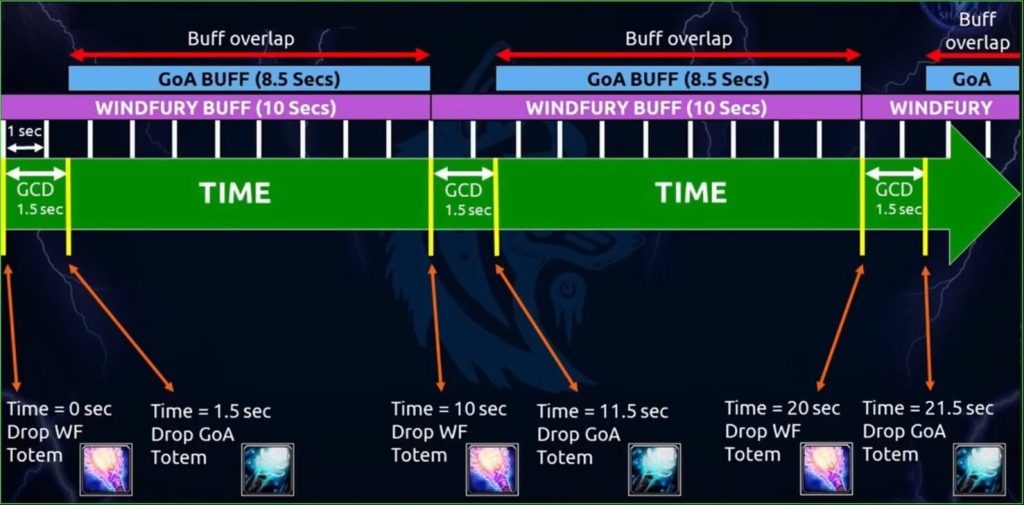
I also tackle the topic of “Why Totem Twist” in the main video.
Threat Capping
- There are more threat-sensitive fights in TBC compared to Vanilla Classic
- Because of this, you may notice you are creeping dangerously close to the tank
- If this occurs, the first step is to remove Shocks from your rotation. This is because the majority of your DPS comes from White hits and SS
- And because of Spirit Weapons, these attacks produce less threat
- More bang for your buck as Shocks don’t have any talents that reduce their threat
- The next step would be to stop DPS completely
- However, this will lead to the Shamanistic Rage buff falling off
- To counteract this, you can have level 1 White quality weapons/skinning knife in your inventory to keep this buff up without significantly increasing your threat
- I realize this is pretty try-hard but it wouldn’t be an “advanced” guide without this type of information!
- Note: you can still pull threat this way. Be careful
Talent Discussion
- Ele Subspec:
- Competitive with Resto Subspec, relies more on shock and totem damage
- Downside: likely doesn’t scale as well due to hit in Resto subspec and may be more limited in threat-sensitive fights
- Resto Subspec: Most Shaman will use this build as you get 3% hit from Resto, increasing the white damage from auto attacks
Check out the video for more details.
Elemental Theorycraft Overview
- Primary PvE DPS contribution comes from your lightning spells (Lightning Bolt & Chain Lightning)
- There are 3 possible rotations which depend on fight length and available Haste (will discuss in later slides)
- Shocks, primarily Flame Shock as it is the highest single DPS Shock, are only used when moving
- This is because:
- 1. Shocks are expensive
- 2. Most mechanics in raids force you to be at max range
- This is because:
- Maintaining high Crit, Water Shield, and MST is incredibly important for mana conservation
- Because of Elemental’s high Hit and Crit from talents, itemization is very straightforward
- Outside of rotation and mana management, 100% uptime of Totem of Wrath and Wrath of Air Totem is required
Possible Rotations
- Lightning Bolt Spam: This rotation is good when fights are exceptionally long (>5 minutes)
- Lightning Bolt (LB) has a lower mana cost than Chain Lightning (CL) and can be spammed for longer periods of time
- Sacrifices the higher DPS of Chain Lightning (shorter cast time and higher top end until approximately 1189 Bonus Spell Power)
- Even though LB out scales CL in total damage, CL’s DPS will always be higher thanks to its 1.5 sec cast
- 3LB:1CL: This rotation is for encounters that are shorter than 5 minutes or when you are confident you can sustain your mana
- Since CL has a 6-sec CD un-hasted, you can perfectly fit 3 LB’s (2 sec cast time thanks to Lightning Mastery) in that time window
- 4LB:1CL: This rotation is only viable if the above conditions are met and you have enough Haste to squeeze 4 LB’s in before a CL CD reset
- Recommended to be at approximately 10% Haste (158 Haste Rating)
- However, its more complicated (next section)
Minimum Haste Required for 4LB:1CL
- Ignore the red line as TBC will likely launch as 2.4.3
- As you can see, the amount of Haste to make 4LB:1CL optimal depends on how much SP you have.
- This is because time spent casting a fourth LB is sometimes beneficial even if CL is close to coming off CD.
- Having T6 4pc lowers the amount of Haste needed to use this rotation as LB’s damage is buffed
Stat Priority
- Because Elemental Shaman come out of the gate with a whopping 12% Hit and 13% Crit thanks to talents and Totem of Wrath, Stat priority is painless compared to Enhancement
- This leads to the following Stat Priority:
- Spell Hit until reaching 16% – only need 4% from gear (51 Spell Hit rating)
- Only 3% needed for Draenei!
- Crit until reaching ~40% w/ talents, unbuffed. Also works amazing with The Lightning Capacitor
- Elemental Shaman will get the most out of this trinket due to high crit and faster cast speeds compared to other casters (~30 casts/min compared to 20-25)
- Spell Power
- Haste until 4LB:1CL is optimal
- Reference Chart on previous slide
- If mana is an issue, you can always just spam LB
Why So Much Crit?
- Crit not only increases the damage of an Elemental Shaman, but it also increases our mana efficiency.
- Because of Elemental Fury, crits do double damage, not 50% more
- Because of Elemental Focus, more crits mean more Clearcasting up-time
- This allows Elemental Shaman to upgrade to more expensive rotations more often
- Makes the most out of The Lightning Capacitor as Elemental Shaman cast so quickly
Lightning Overload Mechanics
- Essentially, the Elemental Shaman’s Windfury
- The beautiful thing about this talent is that its “set and forget”
- Completely passive 10% damage increase (20%/2)
- However, understanding how this talent works with Elemental Focus is important
- Lightning Overload crits will proc/refresh Elemental Focus
- Lightning Overload crits will also proc crit-based trinkets like The Lightning Capacitor
LB and CL Cast Time Reductions
- In TBC, the base cast time of LB is reduced from 3 seconds to 2.5 seconds and CL is reduced from 2.5 to 2 seconds.
- Furthermore, Lightning Mastery now offers only a 0.1 sec reduction per rank instead of 0.2 sec per rank, leading to the same talented cast times as in Vanilla Classic of 2.0 sec for LB and 1.5 for CL with 5/5
- Using our knowledge of spell coefficients, then the LB coefficient should be reduced from 86% (3/3.5) to 71% (2.5/3.5) and the CL coefficient should be reduced from 71% (2.5/3.5) to 57% (2/3.5)
- However, thankfully, this is not the case
- Blizzard increased the base coefficients of LB and CL to 80% and 64%, respectively. An increase of ~13% from theoretical levels
- This still results in a nerf of damage of ~7% for LB and ~10% for CL compared to Classic Vanilla
- I don’t know why this is but just be cognizant of it going into TBC.
- Thankfully, more spell power is available, and you will hardly notice this thanks to Lightning Overload which is a 10% buff to lightning damage
Elemental Mastery Notes
- Unfortunately, EM combos will not be possible in TBC Classic
- In patch 2.3.0, CH/Shock combo batches were nerfed (no longer possible)
- Because of this, it isn’t really a combo you will use in raids.
- Instead, use EM on CD when CL is off CD for a free guaranteed Chain Lightning crit.
- Also, very powerful on trash!
Restoration Theorycraft Overview
- One of the most efficient and sought-after healers in endgame PvE
- Primarily due to the power and throughput potential of Chain Heal
- And Bloodlust, of course
- Also, the unique nature of Earth Shield
- Primarily due to the power and throughput potential of Chain Heal
- Success as a Restoration Shaman comes from:
- Knowing which rank and type of heal to use in any situation
- Balancing Itemization for throughput and mana conservation
- I highly suggest reading Egregious’s Resto Shaman Guide on classicwow.live and watching our video (links in description) for more information on all aspects Resto Shaman
- Also visit Egregious’s TBC Resto Calculator!
Intellect vs. Mp5
- Intellect and Mp5 both provide mana, but they do so in opposite ways.
- Intellect represents your maximum mana pool at the start of the encounter
- As well as some crit and HsP (Nature’s Blessing)
- Mp5, on the other hand, generates mana at a rate of 1 int’s worth of mana (15 mana) every 75 seconds.
- Therefore, the worth of Mp5 increases with fight length
- Intellect represents your maximum mana pool at the start of the encounter
- In other words, if we ignore Int based crit and spell power, 1 Mp5 supersedes 1 Intellect after 75 seconds have elapsed
- It is important to have both stats as more Intellect leads to:
- Using your mana consumables sooner and getting more potion/rune CD’s per encounter
- Using consumables more efficiently and optimizing the rotation
- Intellect increases your possible mana deficit, allowing Mp5 to work for longer
- Intellect and Mp5, although opposite in effect, can work together
- Using your mana consumables sooner and getting more potion/rune CD’s per encounter
- Budgeting each stat comes down to fight length. The longer the fight, the more Mp5 you want. However, as more gear becomes available, spell power and greater intellect lets you budget less Mp5 overall.
Static vs. Effective Mana
- Static Mana = “front-loaded” Mana from Intellect (gear and buffs)
- Effective Mana = “back-loaded” Mana you will have access to over the course of an encounter from these sources:
- Mp5
- Consumables
- Mana Tide, Innervate, Shadow Priest
- Spirit-based 5 second rule ticks
- Critical Strike (less healing required)
- Spell Power (more downranking)
- Effective Mana is sometimes challenging to model, but you can estimate its maximum value from the encounter time
- If you want to learn more about Intellect vs. Mp5 and static vs. effective mana, check out my Mana Management Guide (link in References)
Notes on Haste
- The goal of Haste is to reduce the cast time of Chain Heal as low as possible since it is the most common heal used.
- Because of this it is common for Resto Shaman to all Haste gems in T6. The throughput of this heal is that impactful
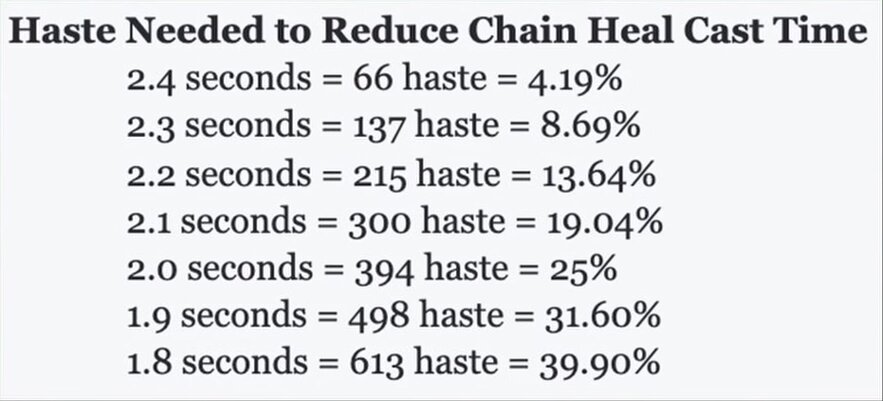
Restoration EP
- Equivalency Points (EP) are a way to compare potential upgrades
- Some upgrades are clear as they provide more of all the relevant stats that you need.
- However, some pieces that are of a similar ilvl are harder to compare as they have a representation of different stats than your current piece
- EP are used in these circumstances
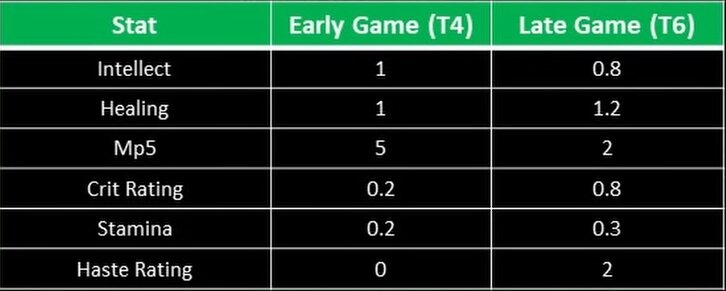
See video for Restoration EP Examples (Late Game).
Spell Use
- Chain Heal
- Your bread and butter and will make up ~85-90% of your heals
- This is because of the large coefficient (95% with Purification and Improved Chain Heal; 165% for all 3 bounces)
- Use whenever multiple targets are taking damage that happen to be near each other (this happens a lot)
- Healing Wave
- Single target “tank” heal that applies Healing Way
- Use Rank 1 when you have free GCDs to keep up Healing Way and a chance to proc Ancestral Fortitude on the Tank
- Lesser Healing Wave
- Fast emergency heal that is used when raid members are about to die and NS is not available, when Chain Heal is ineffective due to positioning, or when the tank is taking large amounts of damage and Inspiration/Ancestral Fortitude is not active
- Earth Shield
- “Leave and forget” tank HOT. Always keep up if you are assigned to do so. Also, can be used on other raiders outside of tanks for niche purposes.
- Provides additional threat to tanks as it is considered healing that they provide to themselves. 0.7475 threat per healing for Warriors and Druid tanks while Paladins also receive mana-return threat via Spiritual Attunement (0.5 threat/mana)
- Water Shield
- Must be active at all times! Refresh when moving or whenever there is a free GCD. As stated, this can also proc Insightful Earthstorm Diamond
- Nature’s Swiftness
- Pair with max rank HW (r12) in emergency situations or whenever it is off CD to correct a healing deficit
Effective Downranking
Below are the “ideal” ranks of each of your spells:
- Chain Heal:
- Rank 1
- Rank 3/4*
- Rank 5
- Healing Wave:
- Rank 1 (HW Stacks)
- Rank 7/8*
- Rank 10
- Rank 12
- (do not go below 5)
- Lesser Healing Wave:
- Rank 5
- Rank 7
* As you profress through the raid tiers and gain confidence in your mana consumption and regeneration you can uprank from CH r3 up to r4 and uprank HW r7 to r8 as well.
TBC Resto Shaman Thoroughput and Efficiency Calculator link: https://docs.google.com/spreadsheets/d/187Bg7MxwStZldbL1faFD3JXUMlgEBYmYd7G9uEaDcJI/
Insightful Earthstorm Diamond
Insightful Earthstorm Diamond’s (IED) MP5 value depends on cast time. IED procs off any spell cast which includes heals, totems, DPS abilities and even Water Shield.
On proc you will receive 300 mana. The proc has a 15 second ICD and as a result the gem has a 3.85% chance to proc if you are approaching it from a 2.5 second cast time.
Haste will reduce the proc rate further and with more than 200 spell haste rating the proc rate decrease to around 3.5%. Here are some MP5 values based on a 3.85% chance to proc (no Haste):
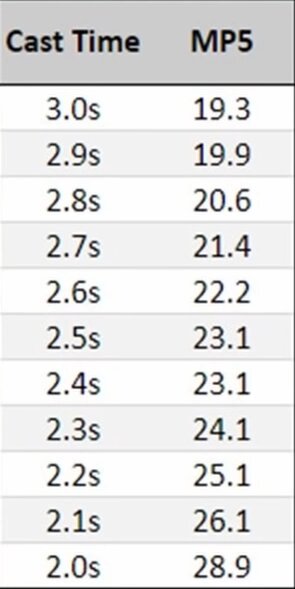
Optimal Raid Composition
- The raid comp shown to the right is optimal in terms of Shaman placement, not particularly in the terms of maximum DPS/Tanking
- Although it is close. You will see most comps look like this (maybe with 1 more Hunter, 1 less Lock)
- The take home message here is place Shaman in the right groups to provide the most benefit to your raid
- Note: You could move the Shadow Priest from Group 5 to Group 3 if you run an Arcane Mage
- Group 1: Enhancement – Provide WF and SoE while twisting in GoA or TAT (if threat is an issue)
- Group 2 and 5: Restoration – Provide MST and MTT. Provide WoA for yourself or other healers (Group 5)
- Note: GoA would be more impactful from a raid-wide efficiency standpoint.
- It may be good for the group 2 Shaman to have a Enh offspec at the ready and sub in another raid healer elsewhere
- Group 3 and 4: Elemental – Provide ToW, WoA, MST
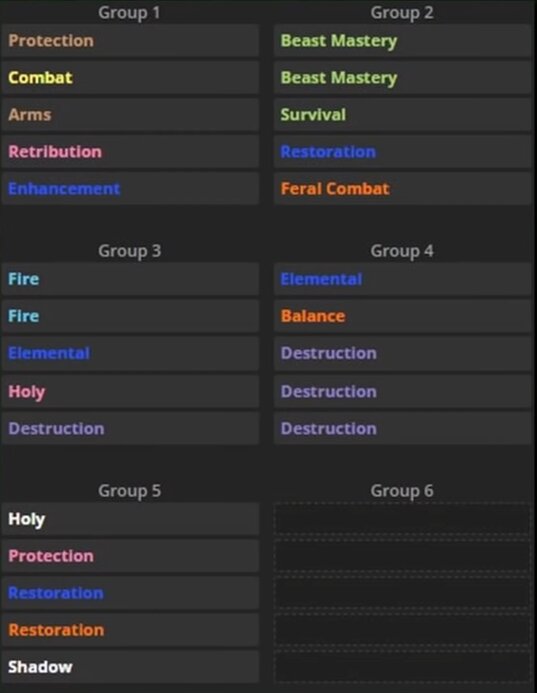
Bloodlust/Heroism Mechanics
- Bloodlust is a party-wide buff in TBC with a 10-min CD given only to the Shaman using it.
- This means you can rotate Shaman into the groups that can make the most out of it
- One strategy is the buff the entire raid during a short burst window
- Another is to rotate BL into the same group 5x (usually Hunter or Warlock group)
- The last is to find a mix of the two
- The “right” decision comes down to the type of encounter and limitations imposed by mechanics
Notes on Threat
Even though both factions now have access to Paladins and Blessing of Salvation (30% threat reduction), threat produced by DPS and healers is more of a consideration in TBC compared to Vanilla because:
- Warrior tanks will likely be deep Prot and not dual-wield Fury. This is an overall reduction in Warrior threat
- Feral Druids and Paladins are not affected by this however many fights require a Warrior Tank
- Lack of World Buffs significantly decreases tank threat potential (and DPS threat), creating a vacuum of possible threat, primarily for healers but also high DPS classes
- Rosters are smaller, reducing the number of available tanks to likely only 3
- This increases the overall effective healing output as less healers are required to do more, increasing healer threat potential
- And increases the chances DPSers are next on the threat table
- Because of this, be mindful of the threat you are producing, limiting DPS and even healing if it is at all possible without putting your raid in danger
- Be wary of initial threat on pulls and always watch your threat meter!
- Threat reducing talents are required for all Shaman specs in PvE
- Even Restoration with a minimum of 2/3 Healing Grace highly recommended
Leveling your Shaman
- Shaman were confident levelers in Classic Vanilla
- The graph to the right shows the Classic Vanilla leveling landscape by spec
- Elemental becomes the fastest leveling spec around level 40 due to the incredible DPS potential offered by later talents
- However, this came with a trade-off of longer downtime and higher cost due to frequency of drinking
- 2H Enhancement was a close 2nd and was the fastest pre-level 40
- Link to video in References
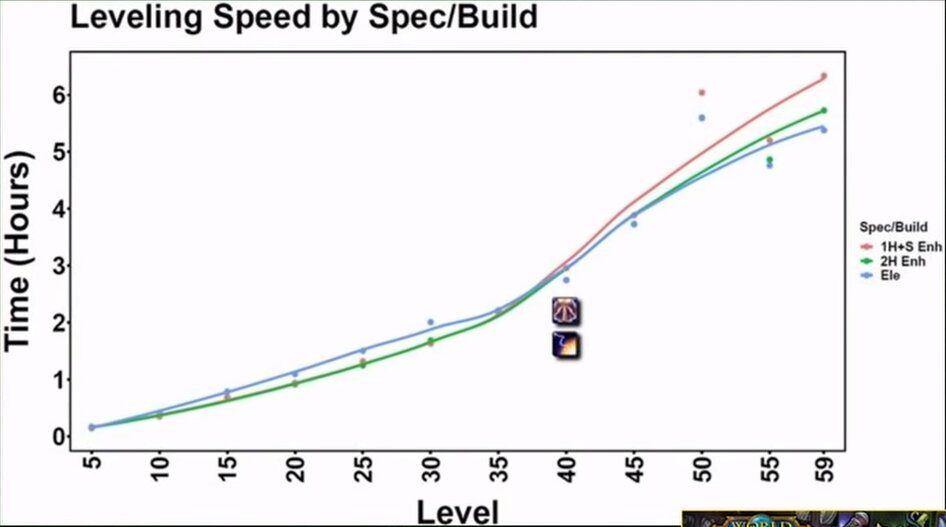
- In TBC, Shaman leveling speed is increased due to buffs to both Enhancement and Elemental trees.
- I suspect, pre-40, the landscape will look very similar to Classic.
- However, 40+, I do not think Elemental will have a significant edge over Enhancement
- This is due to Enhancement doing more damage and becoming more mana efficient
- Elemental also gets an increase in damage and mana efficiency, but I think the boost is more significant for Enhancement
- Either way, it will be close
- Once TBC beta or live comes out, I will be doing a deeper leveling analysis similar to what I did in Classic Vanilla
- There are two theories concerning which spec to go:
- 1. Level the spec you will not play at end game to experience the “other side” keeping any relevant upgrades for your endgame spec
- 2. Level the same spec you will play at endgame to “learn the ropes” if you are not confident in that spec or if you just really love it
- If you are going Resto at endgame, only level Resto if you plan to dungeon grind. Otherwise, pick which one you like the best!
Aldor or Scryers?
- In TBC, you will have the option to build rep with either the Aldor or the Scryers in Shattrath City. Both factions provide unique gear benefits
- You can switch if you’ve made a mistake or if you are a completionist
- Depending on your endgame spec and/or profession, one faction may be better than the other
- However, all crafted gear is blue quality and will be replaced in early endgame
- Furthermore, even the epic quality gear will be replaced (ilvl 100) by T4
- The factions provide shoulder enchants (Sapph’s are better), profession recipes, and rep reward gear
- If you are an Alchemist, only the Scryers offer a new recipe (Elixir of Major Firepower)
- For Tailor’s, the Aldor offer Golden Spellthread (Healing) and the Scryers offer Runic Spellthread (Spell Damage)
- Honestly, the factions are relatively balanced and gear/item upgrades will be outphased rather quickly.
- However, the shoulder enchants could sway your decision!
Aldor & Scryer Enchants
- For Restoration, using the early game EP system, the Scryers provide more Mp5 (Aldor = 38 EP, Scryers = 42 EP). However, using the late game EP system, the Aldor is better as Mp5 loses value. In my opinion, if you don’t want to switch, go with the Aldor as they will be more relevant in harder raids (Aldor = 29.6 EP, Scryers = 26.4 EP).
- For Elemental, the Scryers offer more Crit and I would personally side with them. Also, the +Hit trinket is nice early on to make up for that 4% (3% for Draenei) you need to get hit capped.
- The Aldor are also a perfectly fine choice, especially if you don’t need the extra Crit
- For Enhancement, using the EP system, the Scryers provide more crit which is always weighted higher than attack power in a slightly less than 2:1 ratio. On the surface, it appears the Scryers is better but if you do the actual math using 1.97 as for Crit EP (highest EP across phases), the Aldor eek out slightly over Scryers due to the higher AP value on these enchants (Aldor = 49.7 EP, Scryers = 49.55 EP).
- Because its so close, I’d go with whatever faction aids your professions and early endgame itemization.
User Interface
- A Shaman’s UI is crucial in adapting quickly to a fluid raid environment.
- It is equally important to have both a clear and “drama free” UI as well as a focally centered UI on your screen while maintaining an unobstructed view of the encounter.
- Important things such as cooldowns, totems, and raid frames should be in your direct plane of vision and not in your peripherals
Addons & Weak Auras
- By this point, unless you are new to Shaman, you know the importance of the following Addons:
- Clear, concise Raid Frames
- Totem Timers
- Weapon Rebuff Reminder
- HPS/DPS Addon
- DBM/BigWigs
- Threat Addon
- Item Rack
- Clique or Mouseover Macros (Restoration)
- Swing Timer (Enhancement)
- WF Totem Buff Tracker (Enhancement)
- However, TBC brings some new mechanics to the table that should be tracked with an Addon or a custom WA:
- Water Shield Uptime Tracker
- Cooldown Reminder (SS, Shocks, EM, NS, BL/HR, MTT)
- WF ICD timer (Enhancement)
- Totem Twisting Timer (Enhancement)
- Earth Shield Uptime Tracker (Restoration)

